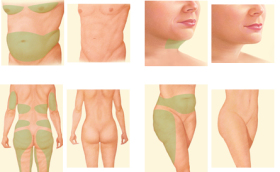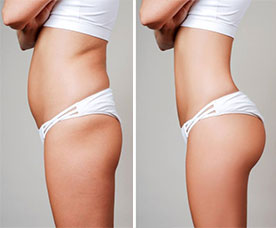
When it comes to fat removal, the miracle method liposuction comes to mind. It is the most effective and permanent method of regional body shaping and the results are visible immediately after the surgery and it is a permanent procedure. For this procedure, the person's body structure is evaluated while standing. Surgery is planned by determining areas that contain more fat compared to other areas.
Liposuction Fat Removal Method
Liposuction method should not be seen as a slimming or weight loss tool. If the goal is to lose weight, the preferred method should be diet and exercise. In liposuction, areas that do not go away with weight loss and are extra fat or protruding compared to other areas are targeted. Liposuction should be treated like a shaving and sculpting process. For example, hips are protruding or fat is accumulated in the abdomen, arms are thick, the upper part of the body is thin but the lower part is thick. In fact, liposuction surgery is a beautification surgery in itself that provides permanent correction of body proportions. I describe this to my patients as a fat rasping surgery, we can describe it as a fat rasping surgery like bone rasping. In this method, the fatty tissue, which is softer and looser than these tissues, is removed by the suction method without damaging the vascular and nerve tissue within the fatty tissue. In order to reduce bleeding and further loosen the fatty tissue, a fluid containing bleeding-reducing drugs is injected into the area at the beginning of the surgery.
It is not necessary to be overweight to have liposuction surgery. In fact, most patients who undergo this procedure have normal weight. No method, including instrumental methods aimed at slimming or regional slimming, is as permanent and effective as liposuction. While other methods achieve results largely through effects such as lymph drainage and dissipation of edema, in liposuction the fat layer is literally removed and permanent slimming is achieved.
What is the Purpose of Liposuction Fat Removal?

Birçok hasta fazla kilo verince vücudunun diğer bölgelerinin daha çok zayıfladığını, örneğin yüzünün çöktüğünü söylemekte ve istediği alanlarda yinede yeterince zayıflama olmadığından şikayet etmektedir. Bu sonuç çok doğaldır çünkü bu kişilerde bu yağ dağılımı yapısaldır, bazı bölgelerde daha fazla birikmiş olabilir ve bu durum genetik olarak belirlenmiştir, liposakşın (yağ aldırma işlemi) bu yapıyı değiştirmeyi amaçlar. Liposakşın yağ aldırma yönteminde incelmesi istenen bölgedeki yağların sadece fazlası alındığından diğer bölgelerle eşit kalınlıkta düzgün bir yüzey oluşur ve yağ deposu olan hücreler dışarı alındığından bu bölgelerin yeniden şişmanlaması mümkün değildir çünkü yağ hücrelerinin üreme özelliği yoktur.
Liposuction yöntemleri nelerdir?

Various device names are used together as variations of liposuction. These methods are the names of liposuction devices mostly used for surgery, that is, they are not actually different methods, they are just liposuction devices that we frequently use. You can find brief definitions of these below.
Vaser Liposuction
The word Vaser liposuction is confused with Laser liposuction surgery due to the similarity of names. It is an abbreviation made from the initials of the words VASER (Vibration Amplification of Sound Energy at Resonance) and has nothing to do with Laser. It is based on the initial softening of the fat tissue with ultrasonic sound waves and then its absorption by liposuction method. During the application, as in other liposuction methods, after some fluid and bleeding-reducing drugs are administered to the area, ultrasonic energy is given under the skin and into the fat tissue, aiming to break down the sensitive fat tissue and fat cells and protect the more durable nerves and vessels. It provides extra benefit in areas such as the breast and back, which have high connective tissue density. It is also successful in gynecomastia surgeries. Postoperative bleeding and bruising are expected to be relatively minimal. However, I would like to remind you that these depend more on the individual characteristics of the person and the corset application.
Laser Liposuction (Laser Lipolysis)
The fat removal process is based on the principle of applying laser under the skin and into the fat tissue to melt the fat tissue and provide tension in the skin. If skin tightening is aimed along with liposuction, this is the method to be chosen. For detailed information about Laser Liposuction, please (link: https://www.sadullahkarun.com/estetik-ameliyatlar/lazer- lipolysis text: Visit my Laser Lipolysis page.
Power Assisted Liposuction
In this technique, a vibration source or a small motor is added to the back of the liposuction cannula, creating excessive vibration at the tip of the cannula, and with this vibration, the fat tissue is broken down. It is a tool that speeds up the surgery and makes it easier for the surgeon. I frequently use it in cases where large amounts of fat need to be removed. During the application, liposuction is performed after bleeding-reducing serums are administered into the tissue, there is a possibility of excessive bruising after the surgery.
Liposuction with the help of Water Spray Method (Water Assisted Liposuction - WAL)
In this method, unlike others, the fatty tissue is separated from its location by water spraying method, not by suction force. Pressurized water is sprayed into the fat tissue through the thin tube placed inside the liposuction cannula and the fat particles are broken off. Since the broken fat particles are absorbed simultaneously with water, the body is not overloaded with water and post-operative swelling in the area is expected to be low. By mixing bleeding-reducing drugs into the spray water, bleeding is reduced, and the water spray pressure is adjusted so as not to affect the fatty tissue and damage the vessels and nerves, preventing damage to tissues other than the fatty tissue.
Since the fat tissue is separated by water spraying method, these fat tissue particles are less damaged and remain alive at an average rate of 85-90%. Among liposuction techniques, it is the method that preserves the vitality of the fat tissue the most. For this reason, the WAL method becomes very important in cases where the fat tissue is planned to be used in another area, because the permanence of the fat tissue placed in another area depends on the viability of these fat tissue grafts. Fat tissue particles injected into another area have a high chance of survival because they are alive in this area and can remain for life. As it is known, fat tissue transfers are frequently used for facial rejuvenation, breast and butt enlargement and leg plumping. For the same reason, the WAL technique gives us better results in obtaining stem cells from fat tissue.
Frequently Asked Questions About Liposuction
Will I get fat again in the same areas after liposuction?
It is not possible for fat to form again in the area after liposuction applications. Because in liposuction, the fat cells that serve as storage in that area are shaved and removed. The excess fat here is corrected proportionally. It is not possible to re-lubricate this area.
Is it possible to lose weight with liposuction?

Liposuction is not a method used to slim down or lose weight. The purpose of liposuction is to beautify and shape the body.
What should I pay attention to after liposuction?
After liposuction, it is beneficial to wear a corset for a few weeks to reduce edema and swelling in the area. Maintaining the current weight is sufficient for the person to maintain the body proportions they have achieved, and there is no need for additional dieting for this. In addition, there is no harm in dieting if one wants to lose weight and become thinner in general.
What is liposuction? Can anyone have liposuction? Who should have liposuction? How is laser lipolysis applied? Is liposuction applied to people who are overweight? Can I lose weight with liposuction? Can I gain weight again after liposuction? What is laser lipolysis? What are the types of liposuction? You can watch the video below about the recovery process after liposuction, fat removal and fat injection operations.






